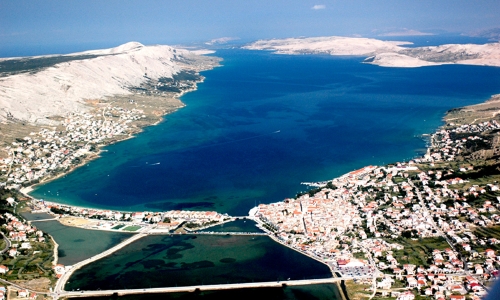Island of Pag Croatia
 The island of Pag is one of the biggest Adriatic islands: it is the fifth largest island with 284.50 square kilometres. Its 270 kilometres of the indented coastline make it the island with the longest coastline on the Adriatic, rich with coves, bays, beaches and capes. The biggest bay, the bay of Pag, is rounded by 20 km of the gravel beaches. Pag is unique due to its vegetation where trees are the most rare form. Therefore, Pag is the largest kingdom of rocky ground on the Adriatic, where thin grass, low aromatic herb cover, sage and immortelle grow. They make the foundation of the nourishment of the island’s sheep on the rocky ground, intersected by long dry stonewalls, giving a special flavour to the well known cheese of Pag.
The island of Pag is one of the biggest Adriatic islands: it is the fifth largest island with 284.50 square kilometres. Its 270 kilometres of the indented coastline make it the island with the longest coastline on the Adriatic, rich with coves, bays, beaches and capes. The biggest bay, the bay of Pag, is rounded by 20 km of the gravel beaches. Pag is unique due to its vegetation where trees are the most rare form. Therefore, Pag is the largest kingdom of rocky ground on the Adriatic, where thin grass, low aromatic herb cover, sage and immortelle grow. They make the foundation of the nourishment of the island’s sheep on the rocky ground, intersected by long dry stonewalls, giving a special flavour to the well known cheese of Pag.
City Pag

The city of Pag is the most historically and culturally interesting place on the island of Pag which remembers a long and turbulent history which numerous monuments can testify.
The city of Pag itself has relocated a few times during its history to be in its present located. The city started being built in the 15th century by architect-urban plan which was made by one of the greatest Croatian builders Juraj Dalmatinac. The very center of the city of Pag today is mostly preserved and renewed. Valuable cultural and historical monuments are: The parish church of St Mary on Kralja Petra Kresimira IV square (St Valentine's reliquary and a miraculous crucifix), the old Tower, the remnants of the town walls, Duke's palace .

Other than the historical monuments, the city of Pag is also known for its cultural richness. The most famous is definitely the Pag lace – recently under the protection of UNESCO as Croatian non-material heritage. Other than Pag lace, there is also Pag attire and Pag dance.
Baskotin – a golden baked bread – is one of the original Croatian products made by Benediction nuns which can only be bought in Sv. Margeret's convent in the center of the city. Baskotin is one of the rare Croatian products which carries the mark „Originally Croatian“ and „Croatian Island Product“.
Local people have been famous for its salt production. For centuries salt production was the most important economic activity in Pag. This is evidenced by salt storehouses built back in the 16 century, where today stands Museum of Salt.

Apart from producing salt (the Pag salt works are as old as the town itself) the inhabitants also raise sheep (the famous Pag cheese and lamb), make wine (paska zutica), and are involved in agriculture and fishing.
The town of Pag is rich in sandy, pebble and stone beaches. The ring of Pag bay consists of 27 km of beaches. You can reach most of the beaches by car, except the ones located in the Pag doors which can be reached exclusively by boat. The largest beach is Prosika located in the immediate vicinity of the center of the town of Pag.








